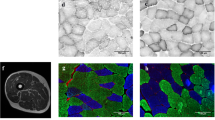Abstract.
Twenty-four 4-year-old Andalusian (Spanish breed) stallions were used to examine the plasticity of myosin heavy chain (MHC) phenotype and the metabolic profile in horse skeletal muscle with long-term endurance-exercise training and detraining. Sixteen horses underwent a training programme based on aerobic exercises for 8 months. Afterwards, they were kept in paddocks for 3 months. The remaining eight horses were used as controls. Three gluteus medius muscle biopsy samples were removed at depths of 20, 40 and 60 mm from each horse before (month 0), during (month 3) and after (month 8) training, and again after 3 months of detraining (month 11). MHC composition was analysed by electrophoresis and immunohistochemistry with anti-MHC monoclonal antibodies. Fibre areas, oxidative capacity and capillaries were studied histochemically. The activities of key muscle enzymes of aerobic (citrate synthase and 3-hydroxy-acyl-CoA-dehydrogenase) and anaerobic (phosphofructokinase and lactic dehydrogenase) metabolism and the intramuscular glycogen and triglyceride contents were also biochemically analysed. Early changes with training (3 months) included hypertrophy of type IIA fibres, a reduction of MHC-IIX with a concomitant increase of MHC-IIA, a rise in the number of high-oxidative fibres and in the activities of aerobic muscle enzymes and glycogen content. Long-term changes with training (8 months) were a further decline in the expression of MHC-IIX, an increase of slow MHC-I, additional increases of high-oxidative fibres, capillary density, activities of aerobic enzymes and endogenous glycogen; intramuscular lipid deposits also increased after 8 months of training whereas the activities of anaerobic enzymes declined. Most of exercise-induced alterations reverted after 3 months of detraining. These results indicate that endurance-exercise training induces a reversible transition of MHC composition in equine muscle in the order IIX→IIA→I, which is co-ordinated with changes in the metabolic properties of the muscle. Furthermore, a dose–response relationship was evident between the duration (in total) of training and the magnitude of muscle adaptations.
Similar content being viewed by others
Author information
Authors and Affiliations
Additional information
Received after revision: 3 July 2000
Electronic Publication
Rights and permissions
About this article
Cite this article
Serrano, A., Quiroz-Rothe, E. & Rivero, JL. Early and long-term changes of equine skeletal muscle in response to endurance training and detraining. Pflügers Arch - Eur J Physiol 441, 263–274 (2000). https://doi.org/10.1007/s004240000408
Received:
Accepted:
Issue Date:
DOI: https://doi.org/10.1007/s004240000408




